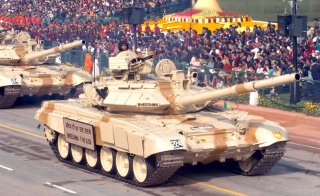Why Russia's T-90S Tank Is Beating China's Armor On The Global Arms Market
Chinese military experts have already voiced displeasure at the PRC’s VT4 and VT5 tanks being passed over in Vietnam’s procurement search.
Here's What You Need To Remember: It should be noted that the export tank’s successor, the markedly more powerful but also more expensive T-90MS, is being offered in addition to the T-90S rather than as its strict replacement. The Kremlin seeks to target different segments of the heavy armor market by continuing to offer the T-90S, which remains viable in a wide range of medium-intensity conflicts across the second and third world.
In a tank world of ever more expensive bells and whistles, Russia’s T-90S tried to tell a design story of modesty and value-driven restraint. Did it succeed?
The Russian military suspended domestic orders of its cheap, effective T-90 tanks in 2011, but continues to offer the T-90S export variant. Russian media reported earlier this week that Vietnam has received over thirty T-90S and T-90SK units, the first batch of a 2016 order for sixty-four of these tanks.
Jane’s Defence Report corroborated this development with a statement from a Vietnamese military insider: "The first batch of T-90S MBTs - totaling no fewer than 30 platforms - was delivered to a Vietnamese seaport in December.
Introduced in 1992 by the manufacturer Uralvagonzavod, the original T-90 battle tank quickly became a staple armor solution of the Russian Land Forces for its cost-effective blend of firepower, handling and durability. Resisting the twin temptations to reverse-engineer the competing American M1 Abrams on the one hand and to splurge on an entirely new design concept on the other, Russian engineers instead opted for a no-frills solution that weaved together the best design principles from their previous T-72 and T-80 tanks. The result was a clear iterative step forward, combining the T-80’s battle-tested 1A45 fire control system with the hull and maneuverability of the T-72.
Notably, they achieved this at around half the production cost of the M1 Abrams. The T-90 jettisoned cutting-edge innovation for raw performance value, a winning strategy for enticing global importers who prioritize cost-effective functionality over the inclusion of the latest cutting-edge technology.
The T-90’s export variant, the T-90S, was largely a copy of the original. It offered the same 125mm 2A46M smoothbore gun, also powered by a 840-horsepower (hp) V-84MS engine. More significant differences were to be found in the T-90SK, a commander’s version featuring additional radio and navigation systems over the baseline T-90.
The T-90S scored a slew of major export successes over the past decade. India purchased over 300 T-90S units, albeit without their integrated Shtora-1 electronic countermeasure (ECM) system. Other T-90S buyers come from a veritable who’s who list of Soviet arms purchasers: Azerbaijan, Turkmenistan, Algeria, Libya and allegedly Venezuela; less likely candidates include Peru.
Most interestingly, the Iraqi government agreed to purchase over thirty T-90S tanks to replace their more expensive M1 Abrams units on the heels of a diplomatic row with Washington.
In a notable illustration of external market forces driving internal modernization, minor improvements to maintain the competitiveness of the T-90S were rolled into the subsequent T-90A upgrade. These included a welded turret and, later, a more powerful 1,000 hp V-92S2 engine.
Rosoboronexport, Russia’s exporting agency, is scheduled to complete the rest of Vietnam’s T-90S order in 2019. While no weapon can retain market relevance forever, the T-90S has proven remarkably resilient due to a series of sound design choices on the part of its manufacturer.
It should be noted that the export tank’s successor, the markedly more powerful but also more expensive T-90MS, is being offered in addition to the T-90S rather than as its strict replacement. The Kremlin seeks to target different segments of the heavy armor market by continuing to offer the T-90S, which remains viable in a wide range of medium-intensity conflicts across the second and third world.
The T-90’s fiercest competition comes from China’s burgeoning armor export catalog. Chinese military experts have already voiced displeasure at the PRC’s VT4 and VT5 tanks being passed over in Vietnam’s procurement search.
Mark Episkopos is a frequent contributor to The National Interest and serves as a research assistant at the Center for the National Interest. Mark is also a Ph.D. student in History at American University. This article first appeared last year.
Image: Reuters

